Published
on 27
Mar 2021
|
All rights reserved.
|
|
|
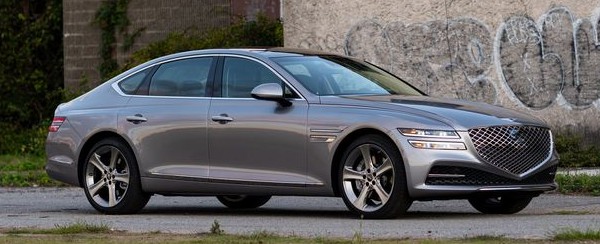
|
|
Each
iteration of Genesis models sorts out a weakness. For the latest G80,
that must be styling.
|
|
You can see Hyundai
invested a lot of money to build Genesis, probably even more than what
Toyota spent in Lexus in the 1980s and 90s. In the beginning, Genesis
was only a premium model selling under the Hyundai brand. From 2016, it
became a luxury brand, and the car was renamed to G80. At the same
time, Luc Donckerwolke, famed for Lamborghini Murcielago, joined as its
design boss, while Albert Biermann, former BMW M division engineering
boss, started overseeing its R&D. More dedicated models added in
the following years, i.e. G90, G70, GV70 and GV80, and its cars are
getting good reputation for driving dynamics, build quality and most
recently, elegant design. A new star is born. Its European and Japanese
rivals should fear.
Each iteration of Genesis models sorts out a weakness that used to be
criticized by road testers. For the latest G80, that must be styling.
While the first two generations of Genesis were hardly ugly ducklings,
they failed to build a character of their own. Unlike them, the third
incarnation looks far more original and unique. Yes, the massive
diamond-shape mesh grille might be over the top, but it delivers the
same presence as a Bentley. More remarkably, the new car has a very
streamline shape. Soft lines flow smoothly from the nose, over the
curvy roof to the slim, slightly concave tail, merging flawlessly with
the split head- and tail-lights. It has some British richness, some
American futurism and some German solidity in equal, yet it doesn’t
look like any others. Good job!
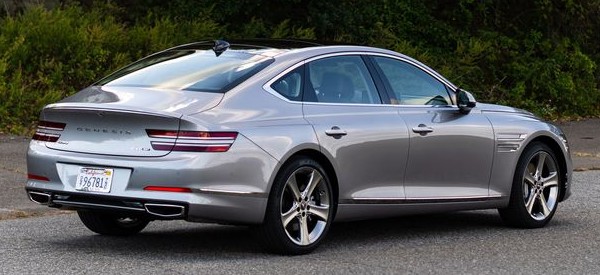
|
|
It
has some British richness, some American futurism and some German
solidity in equal, yet it doesn’t look like any others.
|
|
The roof line of G80 is very fast at the back, extending smoothly to a
waterdrop tail. However, Hyundai said rear headroom is not affected,
since the rear seat is mounted lower. Open the rear doors, you really
find a spacious seat. Leg and head room are aplenty, even for tall
adults, although a large transmission tunnel makes the third passenger
uncomfortable. The front seats are spacious, too. Only the trunk is
smaller than its competitors.
As before, the G80 is on the large side of its class. Its length slips
just under 5 meters, exceeding BMW 5-Series by 60mm. It is 57mm wider
than the BMW, too, and its 3010mm wheelbase is class-leading. Hyundai
said 19 percent of its body is made of aluminum, helping the car to cut
up to 125kg compared with the last generation. However, I suspect they
must be comparing the new 4-cylinder model with the old V6 model. In
fact, the G80 weighs 200 kg more than the equivalent 5-Series and
Mercedes E-class, so it needs larger engines to serve the same
performance, which hurts fuel economy.
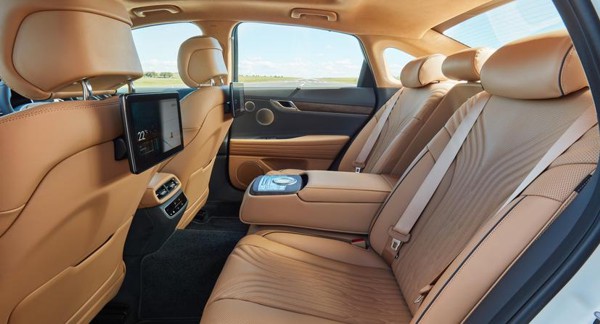
|
|
The G80 is on
the large side of the class, which is evident in its cabin.
|
|
Some of the weight gain might be attributed to the solid build quality.
This is evident in the cabin, where grained wood, real alloy and supple
leather deliver an upmarket perception. Admittedly, some parts are
metallic
plastics, but they look real enough. The dashboard and console are
tastefully designed. Switchgears show attention to details. There are
no signs of cost cutting.
Where it fails to match the established German rivals is infotainment
system. While the G80 offers large screens, i.e. a 12.3-inch instrument
panel and a 14.5-inch touch screen at above the center console, the
latter is placed too far for easy reach when you are driving. You tend
to use the iDrive-style rotary control instead, but unfortunately, it
is recessed flush with the transmission tunnel so that difficult to
access without looking at it. Moreover, it is positioned too far as
well. Instead, your hand rests on the rotary shifter, confusingly.
Maybe this is what the next generation car shall sort out.
The G80 can be very well equipped, such as a 14-channel, 21-speaker
Lexicon sound system, 16-way adjustable seats, soft-close doors, window
shades and laminated glass, but you need to opt for the Prestige
package to get them. It still beats its rivals for value for
money, but the gap is narrower than ever. Perhaps it is time to recoup
the years of investment.
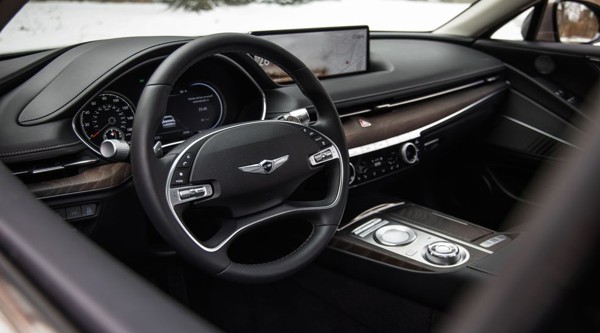 |
|
High quality
cabin is let down by only an unintuitive infotainment control.
|
|
While its styling and build quality impress, the mechanical aspect
still leaves some room for improvement. Hyundai offers it with 3
engines. A new 2.5-liter 4-cylinder turbo with 304 horsepower and 311
lbft of torque serves as entry-level power. It is practically the same
engine that serves Sonata N-line, just turned to longitudinal mounting.
Taking less than 6 seconds to go from 0-60, it doesn’t lack
performance, but the long-stroke 4-pot engine is not as sweet revving
as smaller ones of its rivals, as evident in its coarse, uninspiring
noise. Fortunately, the G80 uses a lot of sound insulation to shut the
noise from the cabin.
The flagship engine is a 3.5-liter twin-turbo V6, enlarged from the
3.3-liter mill that used to serve the old car. It pumps out 380 horses
and 391 lbft of torque, capable of propelling the 2-ton executive car
to reach 60 mph in just under 5 seconds. That is competitive enough
facing the likes of 540i and E450, but again, the Hyundai V6 is neither
as smooth nor as sonorous as its rivals’ straight-sixes, stressing on
quantity instead of quality. You should miss the 5-liter Tau V8 of the
old car.
Engine downsizing is a market trend hard to resist, of course, but the
G80 bucks the trend by offering a diesel engine instead of a plug-in
hybrid option. This 2.2-liter turbo diesel four produces only 210hp and
325 lbft, satisfying no one other than company car buyers in Korea.
Without a plug-in hybrid, the G80 sacrifices not only European market
but also the future.

|
|
There is still
some room to be improved in its dynamics...
|
|
All these engines mate with Hyundai’s own 8-speed automatic
transmission, whose gearshift is smooth, if not as responsive and
accurate as the ZF 8HP or 9G-Tronic employed by its rivals.
The G80 rides on the M3 platform dedicated to the group’s large
rear-drive cars. Its front-to-rear weight distribution is very good at
52:48. The chassis is rigid. The all-multi-link suspension and optional
adaptive dampers look promising, as does the optional AWD system. In
addition to the tuning know-how of Albert Biermann, its ride and
handling should be promising. When cruising on motorway, its cabin is
remarkably quiet and the ride is plush. The fat tires generate plenty
of grip. The steering is quick and more communicative than BMW.
However, the suspension tuning is quite soft, resulting in more body
roll in corners and earlier understeer. The damping seems to be signed
off on a day when Mr. Biermann taking annual leaves, otherwise it would
not have been unsettling on occasional bumps. It just lacks the
remarkable composure and body control of the 5-Series and E-class.
This means the G80 remains a better choice for those seeking comfort
over dynamics. It shines in many areas, most notably styling, build
quality and space. Performance is competitive, while refinement is in
high order. Handling, ride and aural experience still need to be
improved though, as is its commitment to low-carbon future. However, it
is evident that the Genesis is inching closer to the top of the class
again. Will the next generation get there?
|
Verdict:     |
Published
on 14
Oct 2022
|
All rights reserved.
|
|
Electrified G80
|
|
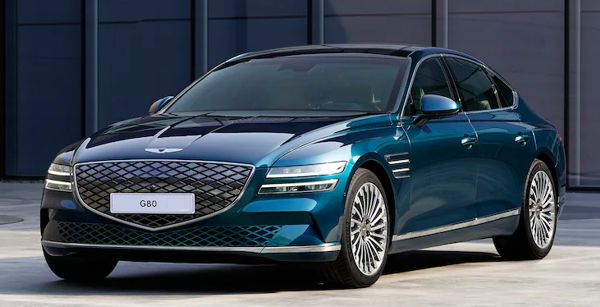
|
|
Electrified
is distinguished by sealed grilles.
|
|
When a car is called
“electrified”, normally it means the internal combustion engine is
assisted with electric motors. Somehow, the “Electrified” in Hyundai
Genesis G80 refers to full electric power, getting rid of engine
completely. Other brands would adopt all-new monikers like i4 or EQA to
signal the big change, but Genesis doesn’t want to distract its
marketing efforts of building the G-series nameplates.
Like BMW’s CLAR platform, Genesis’ M3 platform is adaptable to
full-electric power. When so configured, the Electrified G80 has its
87 kWh battery placed underneath the floor like skateboard EV
platforms,
while each axle gets an electric motor with identical output for 4WD
capability. Total output is 370 horsepower, just 10 hp adrift of its V6
twin-turbo sister, but it strikes back with 516 pound-foot
of torque, versus the petrol motor's 391, and the electric torque is
readily
available from very low revs. As a result, although the car carries 300
kg of extra weight, it is quicker to accelerate until three-figure
speed. 0-60 is quoted at 4.7 seconds, while Car and Driver found it
quicker still. The only regress from the petrol model is top speed,
lowered from the usual 155 mph to 139 mph. That said, unless you live
near Autobahn, it is not an issue. WLTP range is rated at 323 miles or
520 km, not quite as remarkable as Mercedes EQE350 (631 km) but still
pretty good. Hyundai's 800V electrical architecture and 350kW DC fast
charger allows 10-80 percent charging to be accomplished in 22 minutes.
As the chassis needs to be modified, Hyundai takes this opportunity to
improve it further. Some steel structural parts have been replaced with
aluminum or even carbon-fiber items, not only cutting 46 kg but also
increases chassis rigidity, which enhances refinement. Otherwise, there
are not much change to the chassis. The suspension still gets adaptive
dampers with camera-based road-scanning function.
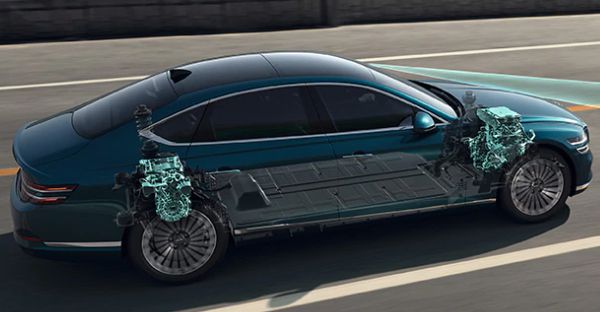
|
|
Battery
is placed at floorpan to save space and keep center of gravity low, but
rear passenger space still takes a hit.
|
|
On the road, the electric power is well governed, avoiding the overly
eager throttle response of Tesla thus suits very well the manner of a
luxury saloon. The smooth power delivery combines with lack of engine
noise results in impeccable refinement. Only at very high speed you
will hear some motor whine, yet not too intrusive. The cabin is also
well insulated from road and wind noises.
The stiffer chassis copes well with the increased mass, as the big car
keeps a smooth ride on all but the worst surfaces. The steering, body
control and balance are all up to the job, though it never feels as
sharp or as engaging to drive as BMW 5-Series. This is true to the
existing G80, too, but the extra weight of Electrified moves it further
away from the camp of driver's cars.
If there is anything preventing customers switching from the
petrol-powered G80 to the electric version, it might be accommodation.
The rear motor not only robs the luggage space by 70 liters to 354
liters, but it pushes the rear seat forward. Meanwhile, the
floor-mounted battery raised the cabin floor together with the rear
seat. As a result, rear headroom is reduced by 23mm while legroom
suffers a loss of 71mm. If you are taller than 6 feet, you are likely
to feel head and
leg room in short supply.
The Electrified proves that electric powertrain works in a conventional
luxury saloon. If you love the beautiful looks and the classy interior
of the regular G80, and you like the idea of future motoring, it will
be no-brainer to upgrade to the Electrified. It is quicker, more
refined and not too expensive to buy. Save a smaller rear bench and
cargo space, there is virtually no drawback. However, as European and
American rivals are introducing all-new luxury EVs, the interim step
taken by this car seems a bit conservative, and may lose out to
competition soon.
|
Verdict:     |
|